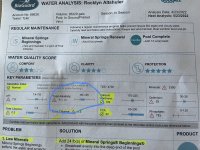False-high TA reading due to cyanuric acid
Cyanuric acid (CYA) titrates as total alkalinity when CYA is greater than 30 ppm. Adjust for this by subtracting 1/3 of your CYA reading from your total alkalinity reading to get the correct alkalinity value. For a more detailed explanation, refer to page 14 in your
2004B booklet.
Technical FAQs
Just to make that clear, what Taylor describes here is not a "false-high TA". CYA contributes to Total Alkalinity, period. It is called
Total Alkalinity, because it includes all sources of Alkalinity, including CYA-Alkalinity. That doesn't make it "false-high".
To use Total Alkalinity as a measure for for the number of Carbonate-ions in the water, that together with also present Calcium-ions can form Calcium Carbonate (Calcite) that can create scaling if the water is oversaturated with Calcium Carbonate, all other sources of Alkalinity (like CYA-Alkalinity or Borate-Alkalinity) have to get subtracted from Total Alkalinity to get
Carbonate Alkalinity. Carbonate Alkalinity can be used to calculate the CSI (Calcite Saturation Index) that tells us how over- or undersaturated water is with Calcite.
Unfortunately, Pool Stores often subtract CYA-Alkalinity from Total Alkalinity and still call it Total Alkalinity. It is not
Total anymore, once you start subtracting things from it. And double unfortunately, even a great company like Taylor adds to this confusion with this statement in their FAQs. What they mean is that the Total Alkalinity value that you got from the drop test needs to be corrected to Carbonate Alkalinity by subtracting CYA-Alkalinity to calculate the Saturation Index with their Watergram. Which is fine, I just wish they wouldn't still call it Total Alkalinity.
Poolmath does this conversion internally when calculating CSI. And so should the calculators that pool stores are using. There is absolutely no need to confuse customers with "adjusted" Total Alkalinity. Triple unfortunately, this works in their favour (and to the customer's financial disadvantage), as the "adjusted" TA will likely be below the traditional limits that they will recommend to correct by adding overpriced baking soda.
@Kaltshuler, no need to worry about all of that. Just use your TF-100 to test for TA (and other parameters), and use PoolMath. And have a good read through TFP's Pool School.




 In your early TFP days, all the terms and recommendations may seem overwhelming. Let me assure you this will not last long. Armed with your TF-100 and the advice by many well-seasoned TFP members, you'll have that pool water in great shape before you know it.
In your early TFP days, all the terms and recommendations may seem overwhelming. Let me assure you this will not last long. Armed with your TF-100 and the advice by many well-seasoned TFP members, you'll have that pool water in great shape before you know it.